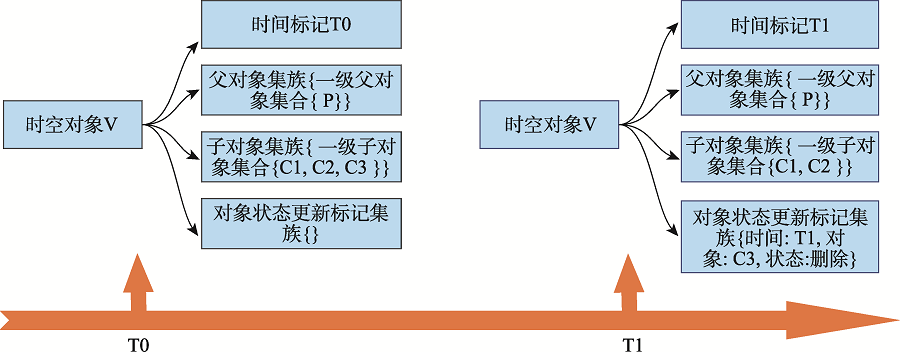

Journal of Geo-information Science >
Research on Expression of Multi-granularity Spatio-temporal Object Composition Structure
Received date: 2020-07-31
Revised date: 2020-10-22
Online published: 2021-03-25
Supported by
National Key Research and Development Project(2016YFB0502301)
National Natural Science Foundation of China(41771426)
Copyright
The construction of pan-spatial information systems and smart cities requires abstracting geographic entities from spatiotemporal objects. The multi-granularity of spatiotemporal objects is reflected as the multi-scale, multi-dimensional, and multi-level characteristics of spatiotemporal objects. In the era of big data, how to organize the information of multi-granular spatiotemporal objects has become a difficult issue in the research of spatiotemporal objects. Based on object-oriented thinking, this paper proposes a set of expression and operation methods for the composition of spatiotemporal objects, which provides a new idea for the orderly organization of spatiotemporal object information. This method is based on the concept of classification theory and divides the composition of spatiotemporal objects into entity object composition and relation. Then we construct the spatiotemporal object information set , object composition set, and relationship composition set to make a complete description of the composition structure of spatiotemporal object. Then we provide related operations on the composition and expression of spatiotemporal objects such as construction, update, destruction, combination, and decomposition to further improve the expression of multi-granular spatiotemporal objects. Finally, we take Luoyu Road in Wuchang District as the spatiotemporal object in this study, and the expression and operation of the structure of the spatiotemporal object are illustrated with examples. The proposed method realizes the expression of the composition structure of multi-granular spatiotemporal objects and reduces the redundancy of the composition of spatiotemporal objects.

LI Rui , SHI Jiahao , DONG Guangsheng , LIU Zhaohui . Research on Expression of Multi-granularity Spatio-temporal Object Composition Structure[J]. Journal of Geo-information Science, 2021 , 23(1) : 113 -123 . DOI: 10.12082/dqxxkx.2021.200423
| [1] |
黄杏元, 马劲松 . 地理信息系统概论(第三版)[M]. 北京: 高等教育出版社, 2008.
[
|
| [2] |
曹闻 . 时空数据模型及其应用研究[D]. 河南:解放军信息工程大学, 2011.
[
|
| [3] |
李德仁 . 展望大数据时代的地球空间信息学[J]. 测绘学报, 2016,45(4):379-384.
[
|
| [4] |
周成虎 . 全空间地理信息系统展望[J]. 地理科学进展, 2015,34(2):129-131.
[
|
| [5] |
华一新 . 全空间信息系统的核心问题和关键技术[J]. 测绘科学技术学报, 2016,33(4):331-335.
[
|
| [6] |
于天星, 李锐, 吴华意 . 面向对象的地理实体时空位置多粒度表达[J]. 地球信息科学学报, 2017,19(9):1208-1216.
[
|
| [7] |
刘朝辉, 李锐, 王璟琦 . 顾及语义尺度的时空对象属性特征表达[J]. 地球信息科学学报, 2017,19(9):1185-1194.
[
|
| [8] |
萧声隽, 宗真, 项丽燕 . 多粒度时空对象空间关系的统一表达与计算[J]. 地球信息科学学报, 2017,19(9):1178-1184.
[
|
| [9] |
江南, 方成, 陈敏颉 . 全空间信息系统认知与表达初探[J]. 地球信息科学学报, 2017,19(9):1150-1157.
[
|
| [10] |
张政, 华一新, 张晓楠 . 多粒度时空对象关联关系基本问题初探[J]. 地球信息科学学报, 2017,19(9):1158-1163.
[
|
| [11] |
丁小辉, 张树清, 陈祥葱 . 时空对象行为分类与形式化表达.[J]. 地球信息科学学报, 2017,19(9):1195-1200.
[
|
| [12] |
陈云海, 江南, 訾璐 . 多粒度时空对象支持下湿地时空行为认知与表达初探[J]. 测绘通报, 2020,2:147-150.
[
|
| [13] |
胡最, 闫浩文 . 空间数据的多尺度表达研究[J]. 兰州交通大学学报, 2006(4):35-38.
[
|
| [14] |
陈军 . 多维动态地理空间框架数据的构建[J]. 地球信息科学学报, 2012,14(1):7-13.
[
|
| [15] |
王艳慧, 李小娟, 宫辉力 . 地理要素多尺度表达的基本问题[J]. 中国科学:E辑, 2006,1(1):38-44.
[
|
| [16] |
|
| [17] |
舒红, 陈军 . 面向对象的时空数据模型[J]. 武汉测绘科技大学学报, 1997,22(3):229-233.
[
|
| [18] |
尹章才, 李霖, 艾自兴 . 基于图论的时空数据模型研究[J]. 测绘学报, 2003,32(2):168-172.
[
|
| [19] |
吴宾 . 基于对象的地理时空演变分析与知识发现[D]. 上海:华东师范大学, 2018.
[
|
| [20] |
成波, 关雪峰, 向隆刚 . 一种面向时空对象及其关联关系动态变化表达的概念数据模型[J]. 地球信息科学学报, 2017,19(11):1415-1421.
[
|
/
| 〈 |
|
〉 |